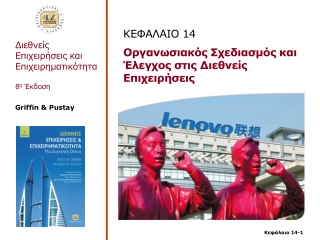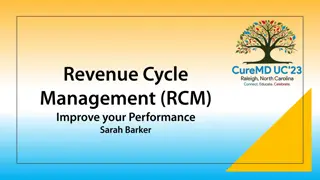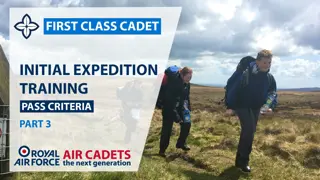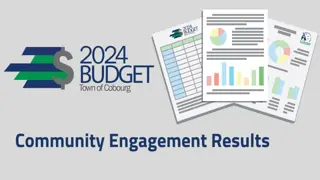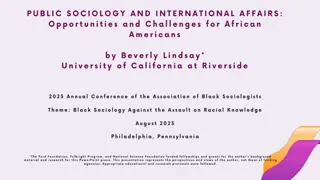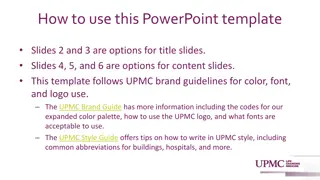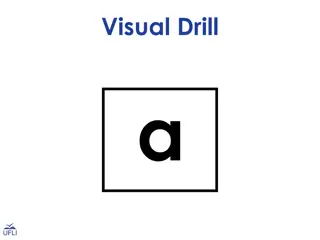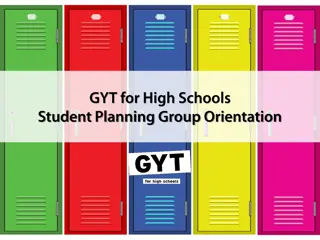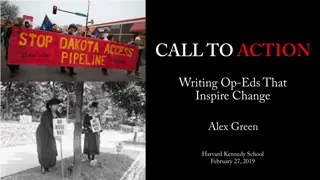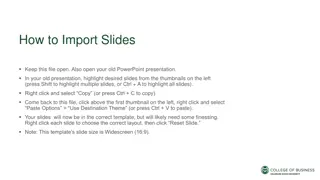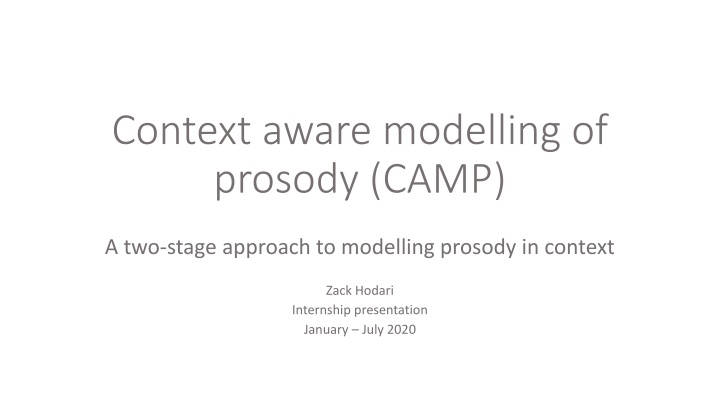
Context-Aware Modelling of Prosody: A Two-stage Approach
Explore the innovative two-stage approach known as Context-Aware Modelling of Prosody (CAMP), aiming to model prosody in context for improved speech synthesis. Discover the relationship between context and prosody, proposed models, duration modelling, prosody representation learning, and more. Understand how context influences prosody and how CAMP addresses challenges in prosody modelling.
Download Presentation

Please find below an Image/Link to download the presentation.
The content on the website is provided AS IS for your information and personal use only. It may not be sold, licensed, or shared on other websites without obtaining consent from the author. If you encounter any issues during the download, it is possible that the publisher has removed the file from their server.
You are allowed to download the files provided on this website for personal or commercial use, subject to the condition that they are used lawfully. All files are the property of their respective owners.
The content on the website is provided AS IS for your information and personal use only. It may not be sold, licensed, or shared on other websites without obtaining consent from the author.
E N D
Presentation Transcript
Context aware modelling of prosody (CAMP) A two-stage approach to modelling prosody in context Zack Hodari Internship presentation January July 2020
Overview Relationship between context and prosody Proposed models Duration modelling Prosody representation learning Prosody prediction using context Evaluation
Speech synthesis In TTS we typically split the problem into three parts Text processing Acoustic modelling Waveform prediction We propose a two-stage acoustic model to directly model prosody stage-1: goal Naturalness (acoustic quality) stage-2: goal Appropriateness (prosody quality)
Prosody is a weak signal Prosody is a channel of communication i.e. It can provide information not already expressed in words It is realised through suprasegmental effects such as: timing (rhythm), intonation (F0), and loudness problem-1: Prosody is a weak signal
Context determines prosody Prosody is determined by the context a speaker sees as relevant Syntax, semantics, affect, pragmatics, setting In TTS our context typically includes only, lexical information (phonemes), and some syntax information (in HUS linguistic features) problem-2: We need more context!
CAMP Context aware model of prosody To address these two problems we proposed a two-stage paradigm stage-1: Prosody representation learning stage-2: Prosody prediction using context Similar to VQ-VAE s learnt prior focusses on phonetic discovery TP-GST focusses on sentence-level style w/o additional context Linguistic linker focusses on on F0 w/o additional context
Methods 1. Tacotron-2 2. Duration modelling 3. CAMP
S2S Tacotron-2 Tacotron-2 like model Sequence-to-sequence with attention
DurIAN+ S2S w/joint duration model Tacotron-2 like model Attention replaced with jointly-trained duration model
ORA Oracle prosody Autoencoder model for representation learning Sequence-to-sequence with jointly-trained duration model Word-level reference encoder
CAMP Predicted prosody Proposed two-stage approach Sequence-to-sequence with jointly-trained duration model Context-based prediction of word-level prosody embeddings
Reference encoder (for oracle prosody) Makes model an autoencoder Embeds mel-spectrogram frames Keep last frame s embedding for each word (downsampling)
Prosody predictor Predicts word-prosody representations Replaces reference encoder which relied on the spectrogram Uses one or more context encoders i.e. Information used in prosody planning
Context features Syntax features Part-of-speech (POS) syntactic role of a word Word-class open/closed class (content/function) Compound noun structure boolean flag Punctuation structure boolean flag Semantic context encoder Fine-tuned BERTBASE
Evaluation 1. Context features 2. Duration modelling 3. CAMP
Data 40 hours of long-form reading content 80-band mel-spectrograms with a 12.5ms frame-shift Durations extracted using forced alignment with Kaldi
Context feature ablation Compare CAMP with different context encoders CAMPsyntax (POS, word-class, compound noun, punctuation) CAMPBERT BERT context encoders CAMPBERT+syntax All syntax context encoders and BERT Context encoder for each syntax features < =
Duration benchmark Determine the contribution of joint duration modelling
CAMP MUSHRA evaluation of our proposed model CAMP DurIAN+ CAMP ORA Nat Lower-bound Proposed Top-line Upper-bound Duration-based Tacotron-2 Predicted prosody specification Oracle prosody specification Natrual speech (no vocoding) 68.8% 37.5% 25.8% < < <
Conclusion Closed the gap between strong duration baseline and natural speech 25.8% Future work 68.8% Improve representation learning 37.5% Improve context modelling
Paragraph level TTS Experimented with improving the prosody prediction Provide wider context by training on paragraphs Informally we found that Sentence transitions were improved Only short sentences had noticeable prosody improvements We need to improve the architecture to fully utilize this context
Speaking rate behaviour As we added more information the speaking rate improved However, the L1 loss got worse This is likely due to the non-Gaussian distribution of durations
Prosody embedding space structure In earlier models we saw three clusters One cluster clearly represented silences Two clusters represented words However, we did not determine the meaning of the two word clusters e.g. average pitch, emphasis, proximity to silences

